Not crawling up my arm, not in my bok choy. Not munching on skin cells in the folds of my mattress. I love insects in their natural habitat, or on the pages of a book, articulated in pen, pastel, or in a wash of watercolour. I love to draw bugs. They are impossibly intricate and lovely, up close. I used to be terrified of creepy crawly things, and I am ashamed to say I stepped on ants, and other insects beetling along sidewalks and pathways, oblivious to humans, concerned only with his or her own buggy life. Now, I almost throw myself off the trails trying to avoid stepping on a bug. The other day, I found myself staring at a dead bee in a windowsill at a bus shelter. I felt a pang of sorrow for the bee, but more than that, I was fascinated by it’s beauty, even in death. I wondered how I could transport this fragile creature home in my pocket for further study and perhaps a drawing. In the end, I left the bee where it was, and eventually walked out into the rain and caught my bus. I’m not willing…yet…to be publicly weird.
As a reformed entomophobic, it’s hard to say how I got to here from there, but I suspect walking in the river valley for 15 years has helped. You either learn to walk in harmony with nature, or you run screaming like a six year old every time a tiny creature flaps it’s wings. A book like Crickwing, by Janell Cannon, does a great service by bringing the lives of the small and the unloved to eye level, for our consideration, education, and hopefully, our appreciation. And Cannon’s illustrations are simply stunning. Not stinging. Stunning.
In just a few pages, Cannon covers topics such as bullying, art, chronic pain, schadenfreude in the insect world, and inter-species cooperation. A young cockroach’s wing is damaged in an unfortunate ‘toad’ incident, and is given the nickname Crickwing. Even amongst cockroaches, fictional cockroaches that is, differences are labeled. (Not sure if actual cockroaches would notice such a thing, as they are too busy making plans for a post-apocalyptic earth.) In spite of his injury, Crickwing is still able to exercise his talents as a sculptor, shaping leaves, roots and petals into edible (and visual) delights, which invariably catch the eyes of his predators. In constant pain, always on the run and never able to finish a meal (such is the price of art), Crickwing shouts, “I’m a mere exoskeleton!”, and then proceeds to exact revenge on the local leaf-cutter ant population, who are even smaller and more vulnerable than the pain-addled cockroach. Bullying 101, chapter 1.
When the Ant Queen comments unfavourably on the decrease in production, the leaf-cutter ants capture Crickwing, and in doing so inadvertently snap his wing back into place. Their plans to use to use Crickwing as a sacrifice to the army ants, who demand regular appeasement (Bullying 101, chapter 2) fails when the leaf-cutters take pity on the cockroach, and release him. Freed from his shackles as well as the pain that had muddled his thoughts, Crickwing offers to help the leaf-cutters fool the army ants. Conflict resolution in children’s picture books is often disappointingly trite. This is especially true of highly anthropomorphized picture books (such as Crickwing), and pretty much every book penned by a celebrity. The stories are didactic, flat as a pancake and about as entertaining as a migraine. However, in the hands of Janell Cannon, a writer and artist of great skill and imagination, the resolution to Crickwing’s dilemma is not only unpredictable, it is deliciously whacked.
Guided by Crickwing’s artistic vision, the ants build a GIANT bug-eyed anteater, made from freshly cut leaves. This is one of the best illustrations in the entire book, but sadly, the image appears to be scan-resistant.
Take my word for it, or better yet, get the book, because this anteater is truly magnificent, especially the tongue. Understandably, the army ants are terrified, and make a hasty retreat. Crickwing is given a permanent job with the leaf-cutter colony as chief food sculptor and anteater groom. All is well in bugsville.
In all of Janell Cannon’s picture books, the artwork is a mix of mediums, from exuberantly colourful and beautifully composed acrylic and prismacolour pencil illustrations, to the finely detailed black & white drawings accompanying the larger paintings. In Crickwing, the funny little vignettes in pen & ink extend the story and give the book an extra visual hit. She also includes several pages of interesting (I think) facts about cockroaches and ants at the back of the book, with realistic illustrations of each of the aformentioned critters. With regard to these drawings, I will admit to a certain prejudice when it comes to pen & ink. It’s my favourite medium.
I’m never sure if it’s god or the devil in the details, but regardless of who dwells in her details, Cannon’s drawings of cockroaches are simply gorgeous. Though I may be seething with jealousy, I doff my hat to this fellow bug lover and illustrator.
In an interview on the Harcourt website, Ms Cannon discusses why she’s drawn (and draws) nature’s less lovely creatures:
“I tend to root for the underdog, and so when an animal is generally misunderstood and unpopular with humans, I question how this bad rep has developed. All forms of life are connected and are important in ways that we often overlook, and I try to show loathed creatures in a new light by digging up information about their ecological significance and choosing species that I think people will find most attractive.”
It’s a wonderful thing to make the ugly beautiful. Not that cockroaches are ugly…
A former graphic designer, California-based Janell Cannon has a number of very fine picture books in publication, but to date, her most popular book is Stellaluna, a beautiful and touching story about a bat. Or, if you like snakes (who doesn’t), there is Verdi, a story about a young snake afraid of growing old and turning green, a fear I share. In my family, these two books are so engrained, and so loved, all bats are Stellaluna, and all snakes are Verdi. Such is the power of storytelling. Such is the power of art.
Crickwing by Janell Cannon, published by Houghton Mifflin Harcourt, Inc, 2000
Stellaluna, by Janell Cannon, published by Houghton Mifflin Harcourt, Inc, 1993
Verdi, by Janell Cannon, published by Houghton Mifflin Harcourt, Inc, 1997


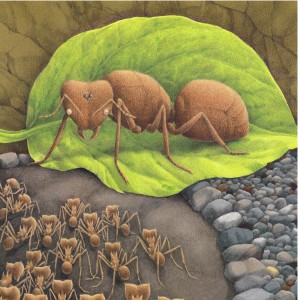
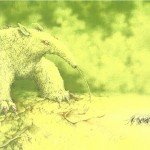


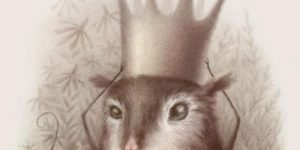
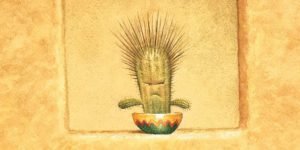

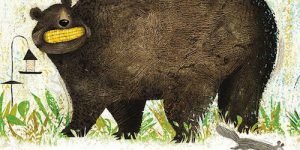
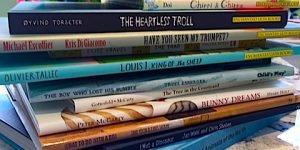

Fabulous looking books, and like you, the kids and I love bugs!
Thanks for making me smile too. It’s not often that you see the word schadenfreude to describe the buggy set :]
Oh, I think this would be a big hit with my kids! It’s not in our library system unfortunately, but I’ve added it to my wishlist 🙂